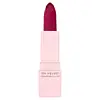Superdrug Studio London Power Pout 12H Satin Lipstick Versus bareMinerals Mineralist Hydra - Smoothing Lipstick
What's inside
What's inside
 Key Ingredients
Key Ingredients

 Benefits
Benefits

 Concerns
Concerns

 Ingredients Side-by-side
Ingredients Side-by-side

Pentaerythrityl Tetraisostearate
EmollientEthylhexyl Palmitate
EmollientPolyisobutene
Octyldodecanol
EmollientSynthetic Wax
AbrasiveEuphorbia Cerifera Cera
AstringentDiisostearyl Malate
EmollientParaffin
PerfumingCera Microcristallina
Emulsion StabilisingCopernicia Cerifera Cera
EmollientSilica
AbrasivePhenoxyethanol
PreservativeAroma
Tocopheryl Acetate
AntioxidantSimmondsia Chinensis Seed Oil
EmollientWater
Skin ConditioningTitanium Dioxide
Cosmetic ColorantIron Oxides
CI 15850
Cosmetic ColorantCI 19140
Cosmetic ColorantCI 45410
Cosmetic ColorantCI 42090
Cosmetic ColorantPentaerythrityl Tetraisostearate, Ethylhexyl Palmitate, Polyisobutene, Octyldodecanol, Synthetic Wax, Euphorbia Cerifera Cera, Diisostearyl Malate, Paraffin, Cera Microcristallina, Copernicia Cerifera Cera, Silica, Phenoxyethanol, Aroma, Tocopheryl Acetate, Simmondsia Chinensis Seed Oil, Water, Titanium Dioxide, Iron Oxides, CI 15850, CI 19140, CI 45410, CI 42090
Ricinus Communis Seed Oil
MaskingDiisostearyl Malate
EmollientEthylhexyl Olivate
Skin ConditioningOctyldodecanol
EmollientOryza Sativa Bran Wax
Skin ConditioningEuphorbia Cerifera Wax
Silica
AbrasiveButyrospermum Parkii Butter
Skin ConditioningPolyglyceryl-2 Triisostearate
EmulsifyingSimmondsia Chinensis Seed Oil
EmollientAroma
Hippophae Rhamnoides Oil
EmollientPunica Granatum Flower Extract
Skin ConditioningGlyceryl Behenate
EmollientPolyester-1
Silica Dimethyl Silylate
EmollientSqualane
EmollientTocopherol
AntioxidantLinalool
PerfumingRicinus Communis Seed Oil, Diisostearyl Malate, Ethylhexyl Olivate, Octyldodecanol, Oryza Sativa Bran Wax, Euphorbia Cerifera Wax, Silica, Butyrospermum Parkii Butter, Polyglyceryl-2 Triisostearate, Simmondsia Chinensis Seed Oil, Aroma, Hippophae Rhamnoides Oil, Punica Granatum Flower Extract, Glyceryl Behenate, Polyester-1, Silica Dimethyl Silylate, Squalane, Tocopherol, Linalool
Ingredients Explained
These ingredients are found in both products.
Ingredients higher up in an ingredient list are typically present in a larger amount.
Aroma refers to an ingredient, or mixture of ingredients, that impart or mask a flavor.
The name is slightly confusing. This is because INCI associates aroma with flavor instead of smell.
Here is the official definition from the The International Cosmetic Ingredient Dictionary and Handbook:
“Aroma is a term for ingredient labeling used to identify that a product contains a material or combination of materials normally added to a cosmetic to produce or to mask a particular flavor.”
INCI shows the only purpose of aroma to be "flavouring".
However, due to regulation differences, some companies may use aroma in place of parfum.
In Canada, this ingredient only has to be listed in concentrations above 1%.
Learn more about AromaDiisostearyl Malate is an emollient and most often used in lip products. It comes from isostearyl alcohol, a fatty acid, and malic acid, an AHA.
As an emollient, Diisostearyl Malate helps create a thin film on your skin to trap moisture in. This helps keep your skin soft and smooth.
Octyldodecanol is a fatty alcohol. It is primarily used to enhance the texture of products.
As an emulsifier, Octyldodecanol helps prevent the oils and waters from separating. It also prevents ingredients from creating foam when shaken.
Octyldodecanol is created by reducing fatty acid to an alcohol.
Due to its high molecular weight, it does not get absorbed into the skin.
Learn more about OctyldodecanolSilica, also known as silicon dioxide, is a naturally occurring mineral. It is used as a fine, spherical, and porous powder in cosmetics.
Though it has exfoliant properties, the function of silica varies depending on the product.
The unique structure of silica enhances the spreadability and adds smoothness, making it a great texture enhancer.
It is also used as an active carrier, emulsifier, and mattifier due to its ability to absorb excess oil.
In some products, tiny microneedles called spicules are made from silica or hydrolyzed sponge. When you rub them in, they lightly polish away dead skin layers and enhance the penetration of active ingredients.
Learn more about SilicaThis oil comes from the seeds of the desert shrub called Jojoba. It is more commonly known as jojoba oil, a non-comedogenic oil.
Jojoba oil does not contain fragrance and has many fatty-acids, making it a great soothing ingredient.
It also contains Vitamin E, a great moisturizing ingredient. Vitamin E is also an antioxidant and protects your skin against oxidative damage.
This ingredient humectant properties, meaning it helps draw moisture from the air. This helps keep your skin hydrated.
While jojoba has antibacterial properties, it is only able to kill some strains of bacteria.
Studies also show it helps in wound healing. In fact, Indigenous cultures have used jojoba as a moisturizer and to help treat burns for centuries.
Fun fact: Jojoba oil similar to natural human skin sebum, so it has a great effect on dry skin. It is also promising with helping to regulate sebum production.
Due to its fatty acid content, Jojoba oil may not be fungal acne safe. We recommend speaking with a professional if you have any concerns.
Learn more about Simmondsia Chinensis Seed Oil